Algebra. If you’re in high school or beyond, then you’ve certainly studied your fair share of algebra. A common question that students pose to teachers is, “when are we going to use algebra in real life?”
Aside from the obvious answer I’ve given to that question, “right now,” there are many practical, real life applications of algebra. We’ll look at 9 such applications today.
Let’s get started!
Converting Celsius to Fahrenheit (true story)
Four engineers and a math teacher vacationed in Mykonos, Greece when one engineer named Jill became ill. The five friends traveled by bus to a local medical clinic where the doctor told them that Jill had a fever of 39.5° Celsius.

This number didn’t mean a lot to the five friends. On the bus ride back to the hotel, without the use of a calculator or cell phone, the friends derived the linear equation to convert Celsius temperatures to Fahrenheit.
Their reasoning went like this:
We know that the freezing point of water is 0° Celsius or 32° Fahrenheit. We also know that the boiling point of water is 100° Celsius or 212° Fahrenheit.
Using the two points (0, 32) and (100, 212), we can write a linear equation in the form y = mx + b, or in this case, F = mC + b, where F is the temperature in degrees Fahrenheit and C is the temperature in degrees Celsius.
Since (0, 32) is on the line, we know that b, the F intercept, is 32. Now we just need to calculate the slope.
Since we have two points on the line, calculating the slope is easy enough. Our slope is the change in F divided by the change in C:
- m = (212 – 32)/(100 – 0)
- = 180/100
- = 1.8
Now, we can write the equation:
- F = 1.8C + 32
To determine Jill’s temperature, plug in C = 39.5:
- F = 1.8(39.5) + 32
- = 71.1 + 32
- = 103.1
Hence, Jill had a fever of 103.1 degrees Fahrenheit. That’s pretty high! Fortunately, she recovered quickly.
Algebra can also help us compare costs to make decisions about budgets.
Determining Costs
Problem: Aaron lives in NYC and needs to take a cab to his destination which is 9 miles away. He is deciding between two popular taxi services. ABC Taxi charges a flat rate of $2.50 plus $0.50 per quarter mile. The Happy Cab charges a flat rate of $4 plus $0.45 per quarter mile. Based on cost, which taxi should he choose?

To compare costs, we first need to figure out how many quarter miles Aaron is traveling. Division helps here: 9 divided by ¼ gives us 36 quarter miles. Now we can set up a linear equation to compare costs.
- Cost = Base Fare + Rate Number of Quarter Miles
For ABC Taxi, the base fare is $2.50, the rate is $0.50 per quarter mile, and the number of quarter miles is 36. Plugging in, we get:
- Cost = 2.50 + (0.50)(36)
- = 20.50
For the Happy Cab, the base fare is $4, the rate is $0.45 per quarter mile, and the number of quarter miles is 36. Plugging in, we get:
- Cost = 4 + (0.45)(36)
- = 20.20
Notice the costs are pretty close! Based on cost, for a 9 mile trip, Aaron should choose the Happy Cab.
Let’s move on to everyone’s favorite topic: taxes!
Taxes
Problem: To help defray the costs of college, Kelly is a server at a local restaurant during her spare time. She wants to figure out how much tax she’ll owe for the year. She isn’t sure how much she’ll make but she figures it will be between $15,000 and $20,000. As a single taxpayer, Kelly finds the following table for the current tax year:
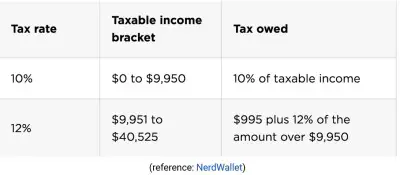
Estimate Kelly’s taxes based on
- a) $15,000 income
- b) $20,000 income
Let’s use algebra to calculate Kelly’s income tax. Both $15,000 and $20,000 fall within the tax bracket of $9,951 to $40,525, so we’ll use the 12% row from the table.
The tax owed at this rate is equal to $995 plus 12% of the amount over $9,950. Let x be Kelly’s income for the year. Converting the table to an algebraic equation, we get:
- Tax Owed = 995 + 0.12(x – 9,950)
Now, we simply plug in the two values.
If Kelly earns $15,000, she will owe:
- Tax Owed = 995 + 0.12(15,000 – 9,950)
- = $1,601
If Kelly earns $20,000, she will owe:
- Tax Owed = 995 + 0.12(20,000 – 9,950)
- = $2,201
Now, Kelly knows what to expect when she files her taxes.
Car Depreciation
You may have heard that if you buy a new car, as soon as you drive it off the lot it depreciates in value! It’s true that, in general, cars depreciate. At least, this was the case before the pandemic!
Let’s assume for our purposes that cars are still depreciating. We can use the formula below to calculate the value of the car after a certain number of years.
| V = V0ert V0 is the original price of the new car e is the irrational constant 2.718… r is the rate of depreciation expressed as a decimal V is the value of the car at time t years of age. |
Problem: Sarah bought a new car for $31,000. Suppose the car depreciates at an annual rate of 6%. What will Sarah’s car be worth in 5 years?
To solve this, we can use algebra and plug in the values to our given equation.
Here, V0 = 31,000, r = -0.06, and t = 5. So we obtain:
- V= 31,000e(-0.06)(5)
- = 31,000e-0.3
- = 22,965.36
In 5 years, Sarah’s car will be worth $22,965 (rounded to the nearest dollar).
Projectile Motion
Problem: Carlos is standing on the end of a 10 foot diving board. From the end of the board, he launches a tennis ball up in the air at a velocity of 36 ft/sec. A short time later, the tennis ball splashes into the pool. The equation for the ball’s height t seconds after launch is given by s(t) = -16t2 + 36t + 10. When does the ball splash into the pool?
To solve this problem, let’s first look at a graph of the function.
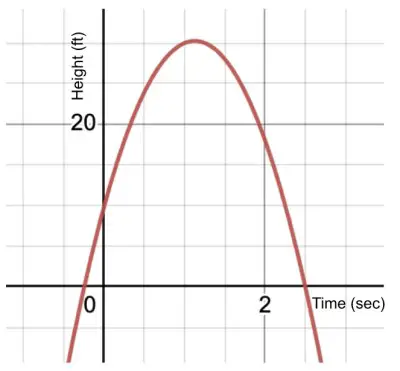
Notice that the parabola shows negative values for time, which won’t make sense in our problem. Let’s keep that in mind as we work through the problem.
When we look at the graph, it’s evident that the ball will hit the water when the height is 0 ft. In other words, we’ll solve for the t-intercepts of the parabola.
Also, notice that we really only care about the second t-intercept since the first one will give us a negative value. Set our equation to 0 and use algebra to solve:
- -16t2 + 36t + 10 = 0
Factor out -2.
- -2(8t2 – 18t – 5) = 0
Factor the quadratic.
- -2(4t + 1)(2t – 5) = 0
Set each factor to 0 and solve:
- 4t + 1 = 0
- t = -¼
- 2t – 5 = 0
- t = 2.5
We obtain two t-intercepts. We throw out our negative value since that doesn’t make sense in this problem. The ball splashes into the pool 2.5 seconds after launch. Our graph also confirms this answer. Hurray!
In the Yard
Problem: A rectangular in-ground swimming pool has a cement walkway of uniform width around the pool. The pool has dimensions 60 feet by 36 feet.
- If the width of the walkway is to be x ft all around, write an expression that will determine the area of the walkway.
- If the area of the walkway is 1,540 ft2, find x, the width of the walkway.
Solution:
- To solve the first part of this problem, we can find the area of the larger rectangle, which includes the walkway, and subtract the area of the smaller rectangle, which is just the pool. (See diagram below.) Notice, the length of the larger rectangle is 60 + 2x and the width of the larger rectangle is 36 + 2x. Be careful here: a common mistake is to only add the width of the walkway once.
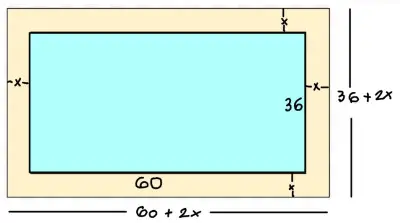
- Area of walkway = Area of Larger Rectangle – Area of Smaller Rectangle
- = (60 + 2x)(36 + 2x) – (60)(36)
- = 2,160 + 192x + 4x2 – 2,160
- = 192x + 4x2
An expression for the area of the walkway is 192x + 4x2.
Since we already have an expression for the area of the walkway, we can set it equal to 1,540 and solve the resulting equation to find x, the width of the walkway:
- 192x + 4x2 = 1,540
Subtract 1,540 from both sides.
- 4x2 + 192x – 1,540 = 0
Factor out 4.
- 4(x2 + 48x – 385) = 0
Factor the quadratic.
- 4(x – 7)(x + 55) = 0
Solve.
- x = 7 or x = -55.
Throw out -55 since a negative number doesn’t make sense in this context. The walkway has a width of 7 ft.
Predicting Height
Algebra can be used to predict various relationships between variables.
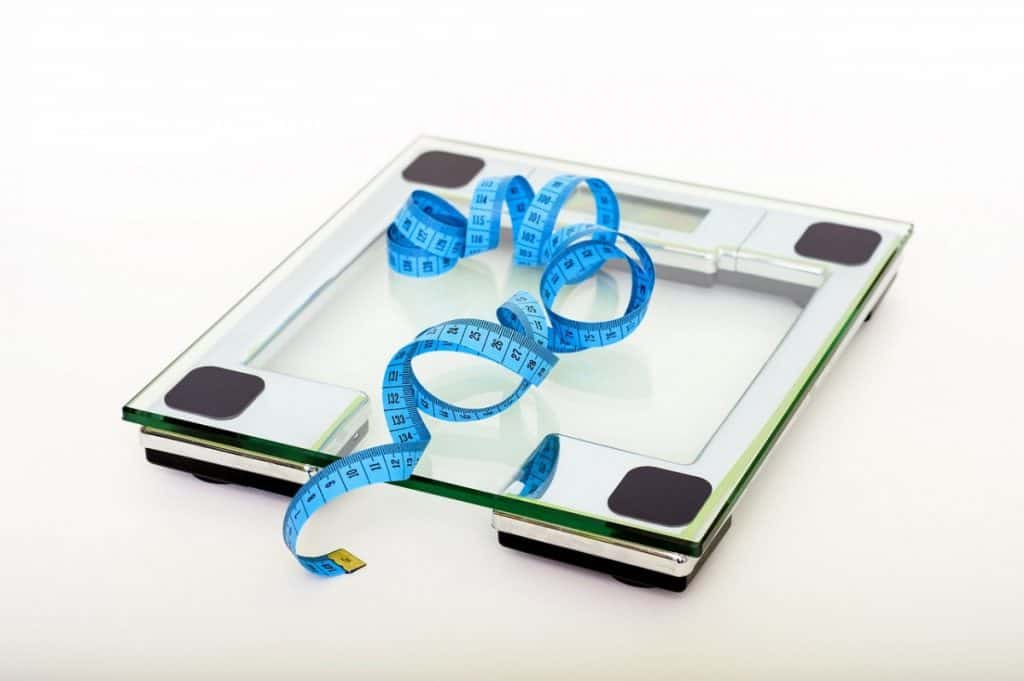
Mayo Clinic has the following example as a possible predictor of height:
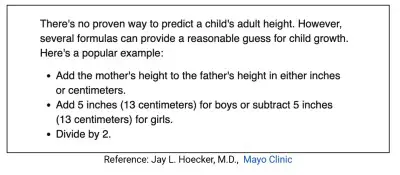
Problem: Vik tries to determine his little cousin Leeya’s height when she’s an adult. Leeya’s mother is 5 ’5” and her father is 6’ 0”. Using the description of the formula above we have:
- Adult Height for a Female = ((Mother’s height + Father’s height) – 5)/2
Convert the heights to inches. Leeya’s mother is 65 inches and her father is 72 inches. Now, plugging our values into the equation above, we get the following:
- Predicted Adult Height for Leeya = (65 + 72 – 5)/2
- = 66 inches.
So, Leeya’s predicted adult height is 66 inches, or 5’6”. I’m not sure how accurate the predictor formula is, but there you go!
Let’s move on to the kitchen…
In the Kitchen

Problem: Natalie is baking an enormous batch of cookies and needs to figure out how much flour and granulated sugar she’ll need. The ratio of flour to sugar in one regular size batch of cookies is 2 cups to ¾ cup. If Natalie has 30 cups of flour in her kitchen and she intends to use all of it to make her enormous batch of cookies, how many cups of sugar will she need?
Once again, algebra to the rescue. You may recognize this as a proportion question. We can set two ratios equal to each other and cross multiply. We’ll start by simplifying the ratio of flour to sugar:
- flour / sugar = 2 / (3/4)
The ratio simplifies to 8/3. Now, let’s set up a proportion using this ratio. Let x be the amount of sugar we need for this enormous batch of cookies.
- 8/3 = 30/x
Cross multiplying, we obtain:
- 8x = 90
Divide both sides by 8 and we have:
- x = 90/8
- x = 11.25
Hence, Natalie needs 11¼ cups of granulated sugar! That’s kind of a lot!
Our last example comes from an equation you’re familiar with from math or science class.
Distance = Rate times Time (D = rt)
Problem: Sophie drives 217 miles from Boston to Burlington, Vermont at an average rate of 55 mph. Assuming she didn’t stop anywhere along the way, how long did it take Sophie to get to Burlington?
- D = rt
Plug in our values.
- 217 = 55t
Divide both sides by 55.
- t = 3.95
It takes Sophie about 4 hours to drive from Boston to Burlington.
Hopefully, you’ve gotten some good ideas on how algebra can help you in life beyond the math classroom!
You can learn about some good reasons to learn algebra here.
I hope you found this article helpful. If so, please share it with someone who can use the information.
Don’t forget to subscribe to our YouTube channel & get updates on new math videos!
About the author:
Jean-Marie Gard is an independent math teacher and tutor based in Massachusetts. You can get in touch with Jean-Marie at https://testpreptoday.com/.


